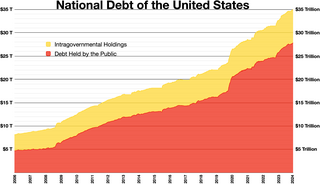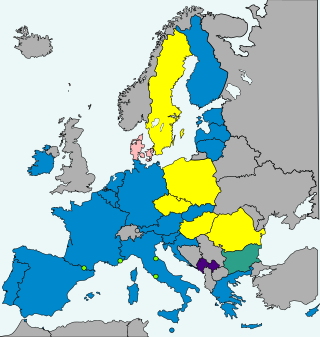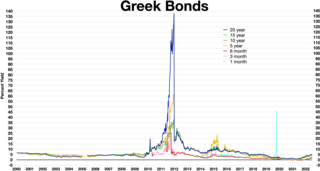Related Research Articles

The economy of the Czech Republic is a developed export-oriented social market economy based in services, manufacturing, and innovation that maintains a high-income welfare state and the European social model. The Czech Republic participates in the European Single Market as a member of the European Union, and is therefore a part of the economy of the European Union. It uses its own currency, the Czech koruna, instead of the euro. It is a member of the Organisation for Economic Co-operation and Development (OECD). The Czech Republic ranks 16th in inequality-adjusted human development and 24th in World Bank Human Capital Index, ahead of countries such as the United States, the United Kingdom or France. It was described by The Guardian as "one of Europe's most flourishing economies".

The economy of Greece is the 53rd largest in the world, with a nominal gross domestic product (GDP) of $242.385 billion per annum. In terms of purchasing power parity, Greece is the world's 54th largest economy, at $416.969 billion per annum. As of 2022, Greece is the sixteenth-largest economy in the European Union. According to the International Monetary Fund's figures for 2023, Greece's GDP per capita is $23,173 at nominal value and $39,864 at purchasing power parity.

The euro area, commonly called the eurozone (EZ), is a currency union of 20 member states of the European Union (EU) that have adopted the euro (€) as their primary currency and sole legal tender, and have thus fully implemented EMU policies.

The national debt of the United States is the total national debt owed by the federal government of the United States to Treasury security holders. The national debt at any point in time is the face value of the then-outstanding Treasury securities that have been issued by the Treasury and other federal agencies. The terms "national deficit" and "national surplus" usually refer to the federal government budget balance from year to year, not the cumulative amount of debt. In a deficit year the national debt increases as the government needs to borrow funds to finance the deficit, while in a surplus year the debt decreases as more money is received than spent, enabling the government to reduce the debt by buying back some Treasury securities. In general, government debt increases as a result of government spending and decreases from tax or other receipts, both of which fluctuate during the course of a fiscal year. There are two components of gross national debt:

A country's gross government debt is the financial liabilities of the government sector. Changes in government debt over time reflect primarily borrowing due to past government deficits. A deficit occurs when a government's expenditures exceed revenues. Government debt may be owed to domestic residents, as well as to foreign residents. If owed to foreign residents, that quantity is included in the country's external debt.

The Stability and Growth Pact (SGP) is an agreement, among all the 27 member states of the European Union, to facilitate and maintain the stability of the Economic and Monetary Union (EMU). Based primarily on Articles 121 and 126 of the Treaty on the Functioning of the European Union, it consists of fiscal monitoring of members by the European Commission and the Council of the European Union, and the issuing of a yearly recommendation for policy actions to ensure a full compliance with the SGP also in the medium-term. If a member state breaches the SGP's outlined maximum limit for government deficit and debt, the surveillance and request for corrective action will intensify through the declaration of an Excessive Deficit Procedure (EDP); and if these corrective actions continue to remain absent after multiple warnings, the Member State can ultimately be issued economic sanctions. The pact was outlined by a resolution and two council regulations in July 1997. The first regulation "on the strengthening of the surveillance of budgetary positions and the surveillance and coordination of economic policies", known as the "preventive arm", entered into force 1 July 1998. The second regulation "on speeding up and clarifying the implementation of the excessive deficit procedure", known as the "dissuasive arm", entered into force 1 January 1999.
A balanced budget amendment is a constitutional rule requiring that a state cannot spend more than its income. It requires a balance between the projected receipts and expenditures of the government.

The economy of the European Union is the joint economy of the member states of the European Union (EU). It is the second largest economy in the world in nominal terms, after the United States, and the third largest at purchasing power parity (PPP), after China and the US. The European Union's GDP is estimated to be $19.35 trillion (nominal) in 2024 or $26.64 trillion (PPP), representing around one-sixth of the global economy. Germany has the biggest national GDP of all EU countries, followed by France and Italy.
The euro convergence criteria are the criteria European Union member states are required to meet to enter the third stage of the Economic and Monetary Union (EMU) and adopt the euro as their currency. The four main criteria, which actually comprise five criteria as the "fiscal criterion" consists of both a "debt criterion" and a "deficit criterion", are based on Article 140 of the Treaty on the Functioning of the European Union.

The United States budget comprises the spending and revenues of the U.S. federal government. The budget is the financial representation of the priorities of the government, reflecting historical debates and competing economic philosophies. The government primarily spends on healthcare, retirement, and defense programs. The non-partisan Congressional Budget Office provides extensive analysis of the budget and its economic effects. CBO estimated in February 2024 that Federal debt held by the public is projected to rise from 99 percent of GDP in 2024 to 116 percent in 2034 and would continue to grow if current laws generally remained unchanged. Over that period, the growth of interest costs and mandatory spending outpaces the growth of revenues and the economy, driving up debt. Those factors persist beyond 2034, pushing federal debt higher still, to 172 percent of GDP in 2054.

Romania's national currency is the leu. After Romania joined the European Union (EU) in 2007, the country became required to replace the leu with the euro once it meets all four euro convergence criteria, as stated in article 140 of the Treaty on the Functioning of the European Union. As of 2023, the only currency on the market is the leu and the euro is not yet used in shops. The Romanian leu is not part of the European Exchange Rate Mechanism, although Romanian authorities are working to prepare the changeover to the euro. To achieve the currency changeover, Romania must undergo at least two years of stability within the limits of the convergence criteria.

The enlargement of the eurozone is an ongoing process within the European Union (EU). All member states of the European Union, except Denmark which negotiated an opt-out from the provisions, are obliged to adopt the euro as their sole currency once they meet the criteria, which include: complying with the debt and deficit criteria outlined by the Stability and Growth Pact, keeping inflation and long-term governmental interest rates below certain reference values, stabilising their currency's exchange rate versus the euro by participating in the European Exchange Rate Mechanism, and ensuring that their national laws comply with the ECB statute, ESCB statute and articles 130+131 of the Treaty on the Functioning of the European Union. The obligation for EU member states to adopt the euro was first outlined by article 109.1j of the Maastricht Treaty of 1992, which became binding on all new member states by the terms of their treaties of accession.
Eurobonds or stability bonds were proposed government bonds to be issued in euros jointly by the European Union's 19 eurozone states. The idea was first raised by the Barroso European Commission in 2011 during the 2009–2012 European sovereign debt crisis. Eurobonds would be debt investments whereby an investor loans a certain amount of money, for a certain amount of time, with a certain interest rate, to the eurozone bloc altogether, which then forwards the money to individual governments. The proposal was floated again in 2020 as a potential response to the impacts of the COVID-19 pandemic in Europe, leading such debt issue to be dubbed "corona bonds".

The European debt crisis, often also referred to as the eurozone crisis or the European sovereign debt crisis, was a multi-year debt crisis that took place in the European Union (EU) from 2009 until the mid to late 2010s. Several eurozone member states were unable to repay or refinance their government debt or to bail out over-indebted banks under their national supervision without the assistance of third parties like other eurozone countries, the European Central Bank (ECB), or the International Monetary Fund (IMF).

Greece faced a sovereign debt crisis in the aftermath of the financial crisis of 2007–2008. Widely known in the country as The Crisis, it reached the populace as a series of sudden reforms and austerity measures that led to impoverishment and loss of income and property, as well as a small-scale humanitarian crisis. In all, the Greek economy suffered the longest recession of any advanced mixed economy to date. As a result, the Greek political system has been upended, social exclusion increased, and hundreds of thousands of well-educated Greeks have left the country.

The Australian government debt is the amount owed by the Australian federal government. The Australian Office of Financial Management, which is part of the Treasury Portfolio, is the agency which manages the government debt and does all the borrowing on behalf of the Australian government. Australian government borrowings are subject to limits and regulation by the Loan Council, unless the borrowing is for defence purposes or is a 'temporary' borrowing. Government debt and borrowings have national macroeconomic implications, and are also used as one of the tools available to the national government in the macroeconomic management of the national economy, enabling the government to create or dampen liquidity in financial markets, with flow on effects on the wider economy.
In the United States, the debt ceiling or debt limit is a legislative limit on the amount of national debt that can be incurred by the U.S. Treasury, thus limiting how much money the federal government may pay by borrowing more money, on the debt it already borrowed. The debt ceiling is an aggregate figure that applies to gross debt, which includes debt in the hands of the public and intra-government accounts. About 0.5 percent of the debt is not covered by the ceiling. Because expenditures are authorized by separate legislation, the debt ceiling does not directly limit government deficits. In effect, it can only restrain the Treasury from paying for expenditures and other financial obligations after the limit has been reached, but which have already been approved and appropriated.
In 2011, ongoing political debate in the United States Congress about the appropriate level of government spending and its effect on the national debt and deficit reached a crisis centered on raising the debt ceiling, leading to the passage of the Budget Control Act of 2011.

The Treaty on Stability, Coordination and Governance in the Economic and Monetary Union; also referred to as TSCG, or more plainly the Fiscal Stability Treaty is an intergovernmental treaty introduced as a new stricter version of the Stability and Growth Pact, signed on 2 March 2012 by all member states of the European Union (EU), except the Czech Republic and the United Kingdom. The treaty entered into force on 1 January 2013 for the 16 states which completed ratification prior to this date. As of 3 April 2019, it had been ratified and entered into force for all 25 signatories plus Croatia, which acceded to the EU in July 2013, and the Czech Republic.
Germany's balanced budget amendment is a fiscal rule enacted in 2009. The law, which is in Article 109, paragraph 3 and Article 115 of the Basic Law, Germany's constitution, is designed to restrict structural budget deficits at the federal level and limit the issuance of government debt.
References
- 1 2 3 "7 Countries with Debt Ceilings or Limits". InvestmentFrontier. 8 October 2013. Archived from the original on 2 August 2021.
- 1 2 3 4 Awadzi, E.A. (2 July 2015). Designing Legal Frameworks for Public Debt Management. International Monetary Fund. ISBN 9781513529561 . Retrieved 19 January 2023.
- ↑ "Debt Limit". United States Department of the Treasury . Retrieved 2019-06-24.
- 1 2 "Why Do Only US and Denmark Have a Debt Ceiling?". USNews. 11 October 2013. Retrieved 19 January 2023.
- ↑ Alan Rappeport. (9 May 2023). "What is the debt ceiling?". New York Times website Retrieved 10 May 2023.
- ↑ "What the United States could learn from Denmark". Financial Times. 26 July 2011. Retrieved 19 January 2023.
- ↑ Kirkegaard, J.K. (28 July 2011). "Can a Debt Ceiling Be Sensible? The Case of Denmark II". Peterson Institute for International Economics. Retrieved 19 January 2023.
- ↑ "There are (much) better ways to control US spending than a debt ceiling". Quartz. 30 September 2021. Retrieved 19 January 2023.
- ↑ "The Constitution of the Republic of Poland".
- ↑ "Government finance statistics". Eurostat. 20 October 2022. Retrieved 19 January 2023.
- ↑ "UPDATE 2-EU debt limit of 60% no longer makes sense - ESM's Regling". Reuters. 5 May 2021. Retrieved 19 January 2023.
- ↑ "Europe rethinking its rules on government debt to meet new global challenges". EuroNews. 6 April 2022. Retrieved 19 January 2023.
- ↑ "EU reaches agreement on spending rules". Euractiv. 12 February 2024. Retrieved 31 March 2024.
- ↑ Thomas Moller-Nielsen (12 March 2024). "Eurogroup says new fiscal rules will require public spending cuts". Euractiv. Retrieved 31 March 2024.
- ↑ "Commission welcomes political agreement on a new economic governance framework fit for the future". European Commission. 10 February 2024. Retrieved 4 April 2024.
- ↑ "Deal on EU economic governance reform". European Parliament. 10 February 2024. Retrieved 4 April 2024.
- ↑ "Commonwealth Inscribed Stock Act 1911". Office Parliamentary Counsel. November 18, 2012 – via www.legislation.gov.au.
- ↑ "Debt ceiling - all because of West Wing?". The Age. October 24, 2013.
- ↑ "Debt ceiling fights ramps up". The Age. November 13, 2013.